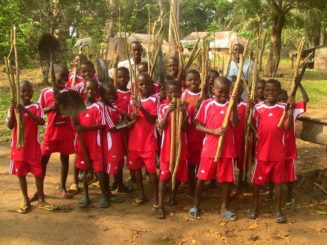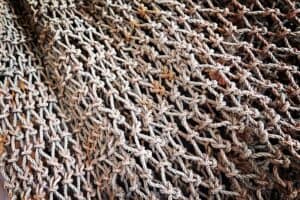
By Rita Chapman
Every summer vacation at Kikongo, packs of bored little boys run through the grasslands and forests, looking for ways to amuse themselves. Their days are filled setting traps for rats, birds, and squirrels, or chopping down saplings for small construction projects. Or even more exciting–fishing for the smallest of minnows with mosquito nets, or sliding down eroded spring paths, or setting grass/forest fires.
Pretty fun stuff, but oh so destructive on the forests and watersheds we all depend on around Kikongo.
Enter…twenty-five 11-year-old boys, dressed in snazzy red jerseys and shorts, armed with shovels and machetes! “Friends of the Congolese Earth” began meeting for the first time a month ago to learn about how we can care for God’s creation around us. During the past 6 weeks, the boys have collected forest seeds for reforesting burnt out watershed forests close to our community springs, have watched them come up with the first rains, have planted hardwood tree cuttings, and have planted 114 acacia trees in bags to create an artificial forest for firewood that they will plant in November. They’ve also learned about erosion and have rehabilitated some of Kikongo’s frequently used paths by digging canals for runoff.
Encouraged to look for erosion taking place in their own yards, I found one young boy digging a well-built gutter off a troublesome path leading to his house one day. In Congo, a well-swept yard is a well-kept yard, so with our hard rains and the daily sweeping of bare earth, truckloads of soil are displaced unless gutters are made.
We’re encouraged to see this small group of Kikongo boys beginning to model new land practices for Kikongo. Their projects are highly visible, inexpensive, and easy for others to imitate. Our hope is that by teaching these boys at a young age, they will learn good land practices that will follow them the rest of their lives.
Our hope is that by teaching these boys at a young age, they will learn good land practices that will follow them the rest of their lives.
We have two Congolese colleagues who have helped us out so much, raising and releasing three Congo Clawless Otters in the past few years. They “get” conservation and have been invaluable in helping to communicate, even to children, how important sustainable land practices are to our future in the “garden” God has given us to care for in Congo.
Please pray that the eyes of these boys’ tender young hearts would be opened to God’s love shown through the wonder of Creation. And, that they would delight in learning to care for it.
Rita Chapman and her husband Glen live in Kikongo, where they were instrumental in moving the Kikongo pastoral training school up to university level. Both teach at the university. The Chapmans also work with the very rare and endangered Congo clawless otter, and are involved in introducing beekeeping and in raising rabbits for agricultural training. The Chapmans are also active in planting indigenous trees for reforestation, lumber, firewood and charcoal, and are introducing many varieties of fruit trees to the area.


